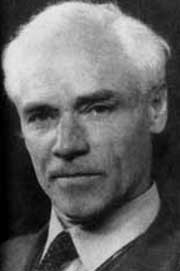Lawrence Wager
Lawrence Rickard Wager was one of the leading petrologists of his generation, known for his exploratory geological work in eastern Greenland and as a member of the 1933 Mount Everest expedition. He also carried out extensive research in the Hebrides, South Africa and the West Indies.

Wager's academic career
Born in 1904, Wager graduated from Pembroke College, Cambridge, where he was a pupil of Alfred Harker and others. He became a lecturer in Petrology and Mineralogy at Reading University before distinguished war service in the RAF photographic reconnaissance branch. In 1944 he was appointed Professor of Geology at Durham and was elected FRS in 1946. In 1950 he assumed the Professorship of Geology at Oxford, and was responsible for transforming a somewhat modest department into one of the leading research institutions of its kind.
Wager's research
Wager discovered the Skaergaard basic igneous intrusion during Gino Watkins' British Arctic Air Route Expedition of 1930-1. Further field studies were undertaken in 1932 and during the thirteen-month expedition he organised with W. A. Deer in 1935-6. The classic memoir describing the intrusion, published in Meddelelser om Grønland in 1939, immediately became a milestone in petrological research, the first detailed structural, mineralogical and petrological study of a layered basic intrusion.
After the end of the war, Wager travelled on a further expedition with Deer and others in the summer of 1953. This added further field observations and, importantly, much more research material, enabling new and fundamental investigations of the mineralogy and geochemistry of the rocks to be undertaken. These included major studies of the pyroxenes and opaque oxide and sulphide minerals, and of the distributions in rocks and constituent minerals of many trace elements. Wager died in 1965.
Wager's collections at the Museum
Apart from his major Greenland collections, Wager amassed collections from Skye, Rum and other parts of the Hebridean Tertiary Igneous province, including the remote island of St. Kilda; from the Bushveld Complex in South Africa; and from the 1933 Mount Everest expedition.
Wager also acquired many important specimens of suites of rocks from classic localities around the world, illustrating the work of geologists who had collected and described them. These were assigned to his 'T' (Temporary) Collection, with a view to their being ultimately incorporated into the new accession series of the Oxford department.
The main contents of the Wager Collection can be seen by visiting the online databases of the mineralogy and petrology collections, or by contacting the Museum.
Wager's ascent of Everest in 1933
The Museum has a fascinating set of 244 rocks collected by Lawrence Wager from Mount Everest. Wager climbed the mountain in the unsuccessful attempt of 1933. On 29th May, along with P. Wyn Harris, he managed to reach 28,100 feet, less than 1,000 feet short of the summit. On this assault they found an ice axe belonging to Irvine who had perished with Mallory in the attempt of 1924.
Further reading
F. S. Smythe (1937), Camp Six, Hodder & Stoughton
Hugh Ruttledge (1934), Everest 1933, Hodder & Stoughton
L. R. Wager (1939), The Lachi series of North Sikkim and the age of the rocks forming Mount Everest, Rec. Geol. Surv. India, LXXIV, 171-188.
L. R. Wager (1965), Injected granite sheets of the Rongbuk Valley and the North Face of Mount Everest, Dr D. N. Wadia Commemorative Volume, Mining & Metallurgy Institute of India, 358-380.
Mineralogy and petrology collections homepage
Mineralogy and petrology databases
This article is also available as a fully illustrated PDF
Learning more ... Lawrence Wager (PDF, 87kB)
To read this file you will need to download Adobe Reader
Learning more articles are free to all users for educational, non-profit purposes.
